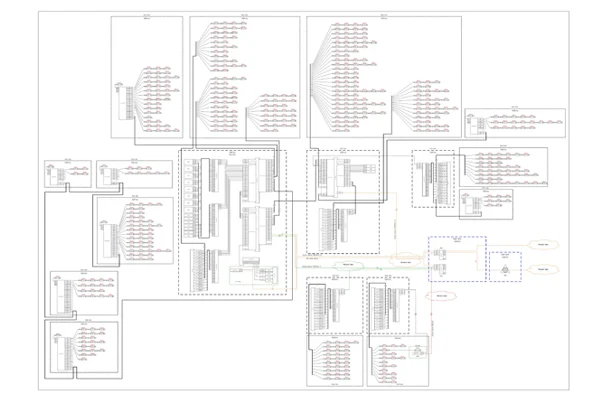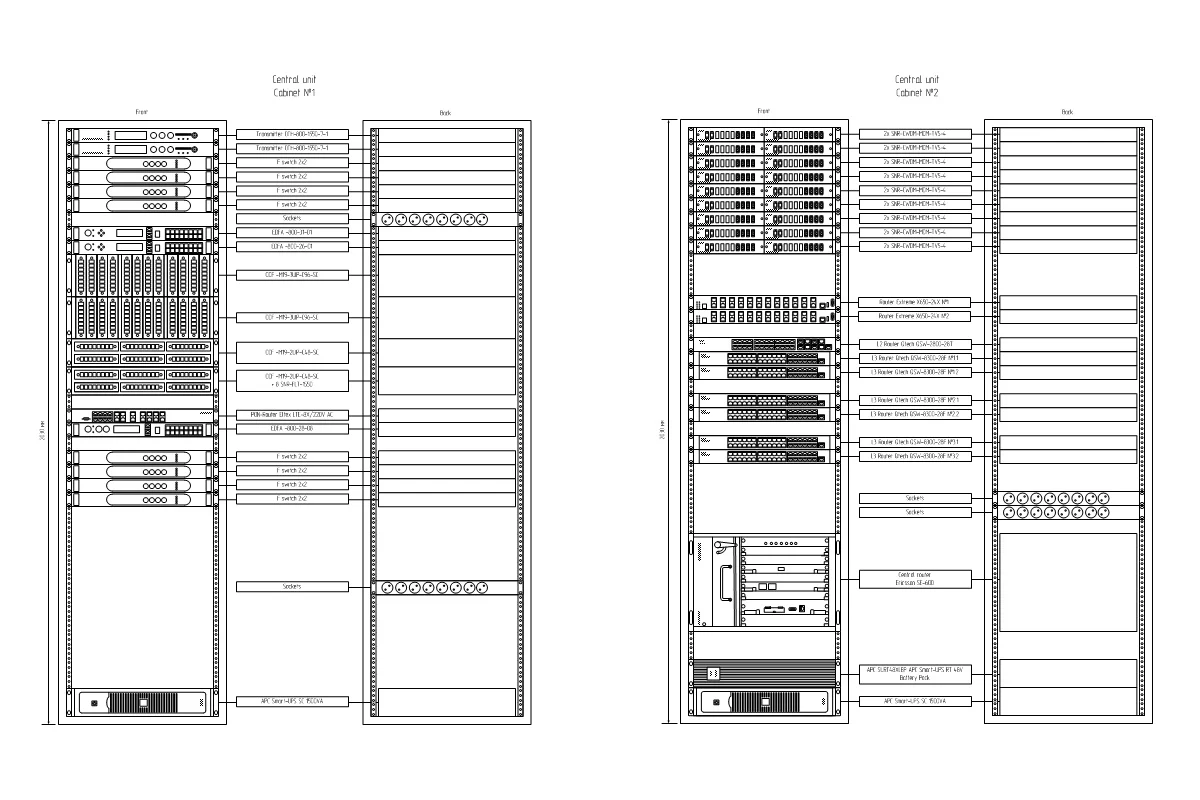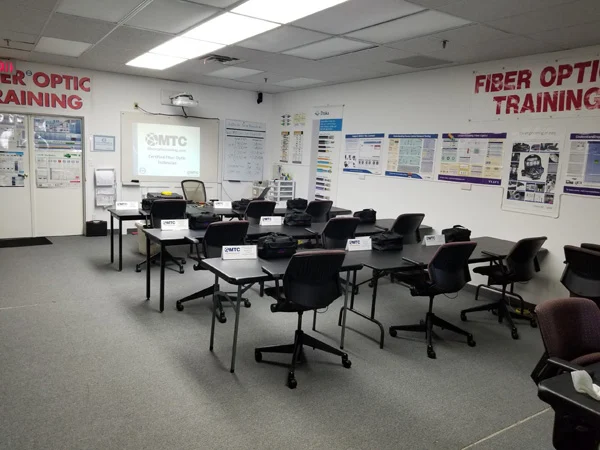
Table of contents
Trends in FTTH network design software in 2024
Challenges in fiber network design in 2025
Perspectives of FTTx network design by 2030
Final conclusion
Trends in FTTH network design software in 2024
In 2024, Fiber to the Home (FTTH) network design software has seen several key trends driven by the rapid expansion of fiber networks globally, the increasing demand for high-speed internet, and advancements in technology. Below are some of the prominent trends shaping FTTh network design software this year:
1. Integration of AI and machine learning for automation
-
- AI-driven design optimization. Artificial Intelligence (AI) and Machine Learning (ML) are increasingly being integrated into FTTH network design software to automate complex design tasks, improve network performance predictions, and reduce human error. AI can simulate network performance under various conditions, helping designers anticipate potential issues.
- Predictive analytics. Machine learning algorithms are used to predict network demand, traffic patterns, and potential failures, enabling better planning and cost efficiency.
2. Cloud-based solutions and collaborative tools
-
- Cloud platforms for remote collaboration. With more teams working remotely, many FTTH network design tools are moving to the cloud, allowing multiple stakeholders (planners, designers, engineers) to collaborate in real-time. Cloud platforms also facilitate data sharing, integration with other business systems, and remote access from different locations.
- Scalability and flexibility. Cloud-based software provides scalability for projects of various sizes, from small rural builds to massive urban networks, offering flexibility for network designers.
3. GIS integration and enhanced geospatial capabilities
-
- Advanced geospatial tools. Geographic Information System (GIS) integration is becoming more sophisticated, enabling designers to overlay network plans on real-world geographic data. This allows for better visualization of terrain, topography, and urban infrastructure, which is essential for efficient fiber route planning.
- Automation of route planning. Tools that automate the process of selecting optimal routes based on geographic data, distance, and existing infrastructure, are becoming more prevalent.
4. Digital twins for network modeling and simulation
-
- Creation of digital twins. FTTH software in 2024 increasingly uses digital twin technology, which creates a virtual replica of the fiber network. This allows network operators to simulate network performance, identify bottlenecks, and test changes before implementing them in the real world.
- Proactive network management. Digital twins also allow for continuous monitoring of the network’s health and can simulate future scenarios to help prevent failures and optimize performance.
5. Design and cost efficiency tools
-
- Automated bill of materials (BoM) generation. Many FTTH design tools now include features to automatically generate the Bill of Materials, allowing designers to quickly estimate the cost of a project based on the network layout and equipment requirements.
- Cost optimization algorithms. These tools help minimize costs by selecting the most cost-effective routes, equipment, and deployment strategies while considering various constraints like right-of-way and terrain challenges.
6. Integration with Network Management Systems (NMS)
-
- Seamless integration with OSS/BSS. FTTH design software is increasingly integrated with Operations Support Systems (OSS) and Business Support Systems (BSS) to streamline the transition from network planning and design to roll-out and operation.
- Automation of maintenance and updates. Integration with NMS allows for real-time updates on network status, enabling automated maintenance schedules and rapid response to network issues.
7. Support for 5G and converged networks
-
- Designing for converged networks. As FTTH networks increasingly support not only home internet but also 5G backhaul, smart city applications, and IoT devices, design software must account for these multi-service use cases. FTTH design tools now offer features that optimize for such converged networks.
- Multi-layer network design. Software now often includes the ability to plan both the fiber layer and the wireless or small cell infrastructure for 5G, making it easier to design networks that support multiple technologies.
8. Sustainability and green infrastructure
-
- Energy-efficient network design. As sustainability becomes a key concern, FTTH software now includes modules that help design energy-efficient networks by considering factors like power consumption of equipment, reducing unnecessary fiber lengths, and incorporating renewable energy sources into network power supplies.
- Carbon footprint estimation. Some tools are incorporating features to estimate the environmental impact of network designs, such as carbon emissions associated with deploying and operating the fiber network.
9. Augmented reality (AR) and virtual reality (VR) for fieldwork
-
- AR-assisted network deployment. Some FTTH design software is starting to integrate augmented reality features, allowing field technicians to view fiber routes, splice locations, and equipment placement through AR devices when on-site.
- VR for design and training. Virtual Reality is being used to provide immersive training for network engineers and to visualize complex network designs in a 3D space before deployment.
10. Faster design-to-deployment cycles
-
- Rapid design iteration. Tools that enable quick changes and iterations to network designs are becoming essential as network operators need to meet tight deadlines for fiber rollouts, particularly in competitive or regulatory-driven environments.
- Automated permit generation. Many software solutions are adding capabilities to automatically generate the necessary permits for fiber construction, make-ready engineering solutions, which help in reducing the administrative time and speeding up roll-outs.
Conclusion for 2024 trends
In 2024, FTTH network design software is becoming more intelligent, cloud-centric, and integrated, while also addressing the complex demands of future-proof networks like 5G and sustainability goals. These innovations are crucial for improving the efficiency, cost-effectiveness, and scalability of fiber deployments worldwide.

Challenges in fiber network design in 2025
By 2025, FTTH (Fiber to the Home) network design software will likely continue to evolve, driven by advancements in technology, growing demand for high-speed broadband, and the need to support emerging applications like 5G, smart cities, and IoT. Here are some anticipated trends that will shape FTTH network design software in 2025:
1. Full integration of AI-driven autonomous networks
-
- AI-powered design and management. AI will become more central to the design, optimization, and operation of FTTH networks. By 2025, AI will not only assist in planning but will also automate much of the design process, from optimal route planning to equipment selection. This could result in fully autonomous network design systems that adapt to real-time data and learn from past deployments.
- Self-healing networks. AI integration in network design software will extend to operations, enabling the creation of self-healing networks. These networks will be able to detect, diagnose, and automatically fix issues without human intervention.
2. Widespread adoption of digital twin technology
-
- More comprehensive digital twins. The use of digital twins will expand significantly in FTTH networks, providing a dynamic, real-time virtual replica of entire fiber networks. These digital models will not only simulate network performance but also provide predictive insights for maintenance, upgrades, and capacity planning.
- Lifecycle management. FTTH network design software will support the entire lifecycle of a network using digital twins – from planning and construction to operations and maintenance. This will allow real-time adjustments based on changing network conditions and user demand.
3. Edge computing and distributed networks
-
- Support for edge computing integration. FTTH networks will increasingly integrate with edge computing infrastructure, as more data processing is pushed closer to the user. Network design software will need to accommodate edge nodes, ensuring low-latency and high-bandwidth connectivity for applications like autonomous vehicles, AR/VR, and IoT.
- Distributed network optimization. Network design tools will incorporate algorithms that optimize fiber networks to support distributed architectures, balancing load and bandwidth between core and edge sites.
4. AI-enhanced 3D and 4D modeling
-
- Advanced 3D and 4D visualization. By 2025, some FTTH design software will likely feature highly detailed 3D and even 4D models that not only show the physical layout of the network but also simulate time-based changes like network traffic growth, infrastructure wear-and-tear, or environmental impacts (such as construction or weather).
- AR/VR-assisted designs. Augmented Reality (AR) and Virtual Reality (VR) tools will become more prevalent for both designing and troubleshooting FTTH networks, allowing engineers to visualize fiber layouts, splice points, and network assets in immersive environments.
5. Real-time geospatial data integration
-
- Instant access to real-time geospatial data. Future FTTH design platforms will pull data from real-time sources such as satellite imagery, LIDAR, drones, and IoT sensors, ensuring that fiber network planning accounts for the latest conditions (e.g., new buildings, changing landscapes). This will allow planners to react quickly to unexpected changes and optimize routes in real-time.
- Advanced terrain and urban data analysis. FTTH software will have better tools for analyzing complex urban environments, automatically adjusting for obstacles like underground infrastructure or changing city planning regulations.
6. Sustainability and energy efficiency as core design metrics
-
- Sustainable design optimization. Environmental concerns will push network design software to prioritize energy efficiency and sustainability. Tools will be designed to minimize energy consumption by optimizing the use of passive network components, reducing fiber lengths, and integrating renewable energy sources for powering remote sites.
- Carbon footprint tracking. By 2025, most FTTH design software will incorporate carbon footprint estimations into the planning process, enabling operators to choose greener alternatives and meet corporate or regulatory sustainability goals.
7. Seamless integration of multiservice networks
-
- Converged networks design. FTTH networks will increasingly be used to support a variety of services beyond home broadband, including 5G backhaul, IoT applications, smart cities, and cloud services. Network design tools will need to address multiservice network architecture, ensuring robust, high-performance connectivity for multiple use cases within a single infrastructure.
- Dynamic bandwidth management. Future FTTH software will include features for dynamic capacity allocation, allowing operators to easily adjust bandwidth distribution based on the real-time demand of different services (e.g., video streaming, gaming, IoT).
8. More granular cost optimization and predictive maintenance
-
- AI-driven cost and resource optimization. Software will increasingly automate the cost optimization of network deployments, calculating the best fiber routes, materials, and installation methods. This will include the use of algorithms to predict the total cost of ownership (TCO) across the network’s lifecycle.
- Predictive maintenance. With the integration of AI and digital twins, predictive maintenance will be automated based on historical data, traffic patterns, and environmental conditions. This allows for the pre-emptive replacement of components before failures occur, reducing downtime and operational costs.
9. AI-driven permitting and regulatory compliance
-
- Automated permit acquisition. By 2025, FTTH design software may feature fully automated systems for generating, submitting, and tracking construction permits, ensuring compliance with local, state, and national regulations. AI will assist in navigating complex regulatory environments, accelerating deployment timelines.
- Dynamic regulatory adjustments. As regulations evolve, AI-driven systems will dynamically update designs to ensure compliance, minimizing delays due to changing standards.
10. Quantum computing and advanced fiber simulations
-
- Quantum computing for complex simulations. As quantum computing becomes more accessible, FTTH design software will leverage its capabilities to perform complex simulations and optimizations that are computationally intensive. This could lead to faster, more accurate network models, especially in dense urban areas with multiple variables to consider.
- Advanced fiber optic simulations. Quantum computing may also improve the precision of fiber optic network simulations, including dispersion, signal degradation, and error rates over long distances, leading to higher network performance and reliability. By now it is a massive problem in submerged fiber networks connecting countries and continents.
11. 5G and beyond: hybrid networks
-
- Seamless FTTH and 5G design. By 2025, software will have fully integrated tools for designing hybrid networks where fiber and 5G coexist seamlessly. These tools will help operators deploy fiber not only for residential users but also for small cell 5G backhaul and other wireless applications.
- Planning for 6G and satellite integration. With the prospect of 6G networks and satellite-based internet becoming a reality by the late 2020s, FTTH software will start incorporating these new technologies into their planning workflows, ensuring the fiber infrastructure can support these next-generation wireless networks.
12. Blockchain and decentralized network management
- Blockchain for secure network operations. Blockchain technology could find its way into FTTH design software to ensure secure, decentralized network management. This might involve using blockchain for managing permissions, recording changes in the network, or even facilitating micro-transactions for shared infrastructure usage in decentralized models.
- Decentralized fiber ownership models. By 2025, decentralized networks enabled by blockchain may allow multiple stakeholders (e.g., municipalities, private ISPs, and individuals) to share ownership and management of fiber network infrastructure.
Conclusion for 2025
In 2025, FTTH network design software will be more automated and integrated with advanced technologies such as AI and quantum computing. These trends will enable more efficient, sustainable, and scalable fiber deployments that meet the growing demand for high-speed connectivity while supporting a range of future services like 5G, IoT, and edge computing.

Perspectives of FTTx network design by 2030
By 2030, FTTx network design, management, and engineering will be shaped by advanced technologies, new demands from consumers and industries, and global trends in connectivity. The “X” in FTTx stands for different types of last-mile fiber connections, and we can expect significant transformations across these aspects of fiber networks. Here are some key trends that will likely define FTTx network design, management, and engineering by 2030:
1. AI and machine learning-driven networks
-
- Fully autonomous network design. AI will dominate network design by 2030, enabling fully autonomous systems to handle everything from fiber route planning to optimal placement of network nodes. AI-driven algorithms will allow for real-time adjustments to designs based on dynamic factors such as user demand, physical obstructions, or regulatory changes.
- AI-enhanced predictive analytics for network management. AI will continue to play a central role in network management, allowing for predictive maintenance, proactive issue detection, and even real-time self-healing networks. Predictive analytics will allow operators to foresee network failures before they occur and plan capacity based on detailed forecasts of demand.
- Self-optimizing networks (SON). Networks will evolve to be more autonomous in terms of traffic management, adapting in real-time to changing conditions like peak usage times, traffic spikes, and equipment failures without manual intervention.
2. End-to-end digital twin integration
-
- Digital twins for entire network lifecycles. By 2030, digital twins will not only be used for planning but for the entire lifecycle of FTTx networks, from construction to operations. These virtual models will mirror the physical network in real-time, enabling detailed simulations, capacity planning, and performance monitoring. Digital twins will also allow network engineers to test potential upgrades and expansions before applying them in the real world.
- Real-time collaboration and visualization. Engineers and planners will collaborate in real-time across geographies using advanced digital twins, enhancing their ability to visualize network issues or expansion plans with highly detailed, 3D, and even 4D models that include time-based scenarios.
3. Hyper-converged infrastructure and multi-access edge networks
-
- Integration with edge computing and IoT. FTTx networks will increasingly integrate with edge computing infrastructure to bring processing power closer to users and IoT devices. Network design and management tools will need to support these multi-access edge computing (MEC) architectures, where fiber networks interconnect seamlessly with local processing hubs.
- Designing hybrid fiber-wireless networks. By 2030, FTTx networks will be designed to not only serve wired internet users but also function as the backbone for 5G/6G and wireless IoT networks. This will require hybrid design strategies that balance fiber-to-premise needs with the dense deployment of small cells and edge computing nodes.
4. Quantum computing and advanced algorithms
-
- Quantum-enhanced network optimization. The use of quantum computing for network optimization will enable FTTx engineers to solve previously intractable design problems, such as optimizing fiber routes through dense urban areas, accounting for countless real-time variables, or maximizing capacity on shared infrastructure. Quantum algorithms will enable network design software to run highly complex simulations that improve performance and resilience.
- Post-quantum security. With the rise of quantum computing, post-quantum cryptography will be crucial for securing FTTx networks. Network engineering will shift to using encryption techniques that can withstand quantum attacks, ensuring secure transmission of data across fiber networks.
5. Sustainable and green network design
-
- Energy-efficient fiber networks. By 2030, sustainability will be a primary design consideration. FTTx networks will be optimized for minimal energy consumption, and green network design principles will be widespread. This will involve using more energy-efficient equipment, reducing the power consumption of data centers, and incorporating renewable energy sources to power remote nodes and fiber hubs.
- Circular economy in network equipment. There will be a shift toward reusable and recyclable components in FTTx network infrastructure. Network designs will consider the full lifecycle of equipment, from deployment to decommissioning, minimizing waste and improving the environmental impact of fiber installations.
6. Dynamic and programmable networks (software-defined networks)
-
- Fully software-defined FTTx networks (SDN). By 2030, FTTx networks will be predominantly software-defined, allowing network operators to configure, manage, and troubleshoot networks programmatically. Software-Defined Networking (SDN) and Network Function Virtualization (NFV) will allow for greater flexibility, enabling real-time adjustments in response to changes in demand or network conditions.
- Intent-based networking (IBN). Intent-based networking will enable network operators to define desired outcomes or “intents” with the network automatically configuring itself to meet those goals. This automation will extend across FTTx networks, improving both efficiency and reliability.
7. Massive growth of fiber network infrastructure
-
- Ultra-dense fiber deployments. By 2030, urban and suburban areas will see ultra-dense fiber deployments as broadband demand soars, driven by smart cities, autonomous vehicles, and the explosion of 5G and 6G wireless applications. Fiber will become the backbone for multiple technologies, including residential broadband, enterprise services, smart grid applications, and edge computing.
- Nationwide fiber coverage. Many countries will achieve near-total fiber coverage by 2030, driven by government initiatives and demand for high-capacity, low-latency connectivity. Rural areas will benefit from large-scale fiber rollouts, likely supported by public funding and subsidies to close the digital divide.
8. Augmented and virtual reality for fieldwork
-
- AR/VR-enabled maintenance and deployment. By 2030, augmented reality (AR) and virtual reality (VR) tools will be widely used by field engineers for deployment, maintenance, and troubleshooting. Technicians will wear AR headsets that display fiber routes, equipment locations, and diagnostic information in real-time as they work. This will reduce errors and speed up the time required for network deployments and repairs.
- AR-assisted remote support. In remote areas, technicians will be able to receive live support from experts located elsewhere via AR. This will allow for faster problem resolution and reduce the need for on-site visits by specialized personnel.
9. Real-time network orchestration and resource allocation
-
- Real-time resource allocation. By 2030, FTTx networks will have highly dynamic resource allocation capabilities, distributing bandwidth, computing power, and storage in real-time based on user demand and network conditions. AI and ML algorithms will make instant decisions on how to allocate resources, ensuring optimal performance and low latency, even during peak times.
- Adaptive traffic management. FTTx network management systems will include intelligent traffic management that adapts to real-time changes in user behavior, ensuring consistent QoS (Quality of Service) for critical applications like telemedicine, autonomous vehicles, and real-time gaming.
10. 5G/6G and satellite integration
-
- Seamless integration with 6G networks. By 2030, FTTx networks will be seamlessly integrated with 6G wireless technology, which is expected to deliver extremely high data rates and ultra-low latency. Fiber will serve as the essential backbone for small cell 6G deployments, ensuring that the increasing number of connected devices can operate at peak performance.
- Fiber-satellite hybrid models. Satellite broadband, especially LEO (Low Earth Orbit) satellite systems, will be used alongside fiber in rural and hard-to-reach areas. Network designs will have to account for hybrid models where satellite links complement fiber deployments, ensuring continuity of service even in regions where fiber rollout is cost-prohibitive.
11. Blockchain and decentralized networks
-
- Blockchain for security and management. Blockchain technology will be used to enhance security, transparency, and management in FTTx networks. Distributed ledger technology will enable secure transactions, resource sharing, and data protection across decentralized network architectures, ensuring verifiable, tamper-proof records of network activity.
- Decentralized network models. In some regions, there may be a rise in decentralized ownership models for FTTx networks, where local governments, private companies, and community groups share control over fiber infrastructure. Blockchain will help facilitate these collaborative efforts by managing network access and data usage efficiently.
12. Next-generation optical technologies
-
- Photonic and all-optical networks. Advances in optical technology will lead to all-optical networks with faster speeds and greater bandwidth. These networks will rely on new materials, including photonic crystal fibers and advances in silicon photonics, enabling networks to transmit data at even higher capacities over long distances without the need for electrical conversion.
- Hollow-core fibers. Bright future for emerging technology of HCF – a hollow-core fiber is an optical fiber which guides light essentially within a hollow region, so that only a minor portion of the optical power propagates in the solid fiber material. Hollow-core fibers can have a much higher damage threshold in terms of transmitted optical average or peak power than solid-core fibers. In contrast to solid glass fibers, hollow-core fibers exhibit extremely weak end reflections: the usual Fresnel reflections at the fiber ends are essentially absent.
- Terabit and beyond-capacity networks. By 2030, fiber networks will be designed to support terabit-per-second transmission rates as demand for data-intensive applications continues to grow. New fiber technologies, such as hollow-core fibers, will be deployed to enable ultra-high-speed data transmission with minimal latency.
Final conclusion
By 2030, FTTx networks will be deeply integrated with other technological ecosystems like edge computing, 6G wireless, and IoT. New advanced optical technologies and new automated design principles will lead to more efficient, scalable, and future-proof fiber infrastructure. Fiber networks become not only a mean of connectivity, but the backbone of digital economies and societies. Hence the fiber network design principles and software should make a leap forward to fulfill the demand in new technologies.
Don't hesitate! Start using splice.me
Create, manage, control all your fiber splicing in one place, fast and easy



